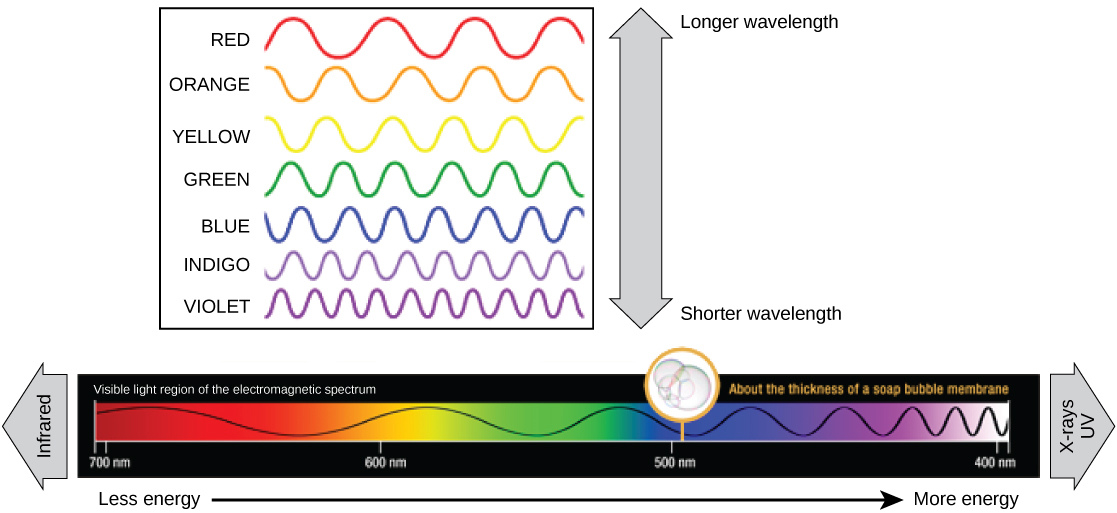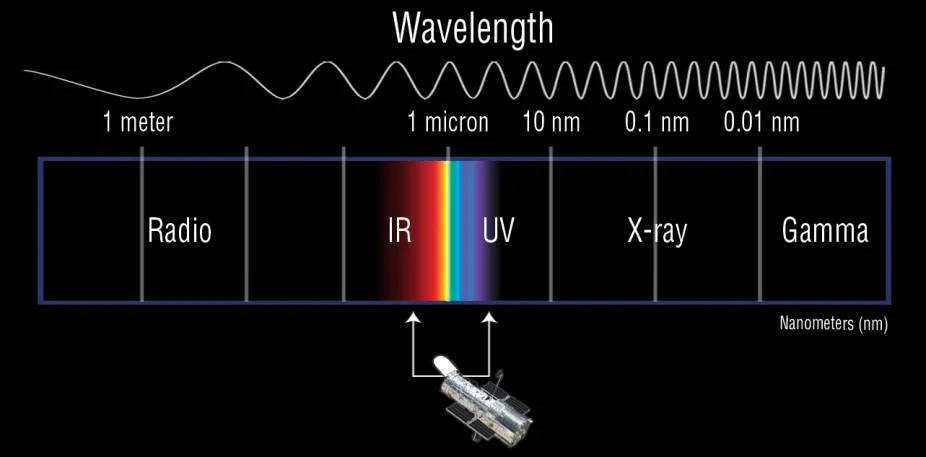Antwort Can humans only see 1 percent of the visible light spectrum? Weitere Antworten – Can humans only see 1% of the visible light spectrum
While we can see 100% of the visible spectrum – not 1% – we see very little of the total electromagnetic spectrum. And that share is even less than 1%. Light visible to humans makes up just 0.0035% of the electromagnetic spectrum.What is the visible light spectrum The visible light spectrum is the segment of the electromagnetic spectrum that the human eye can view. More simply, this range of wavelengths is called visible light. Typically, the human eye can detect wavelengths from 380 to 700 nanometers.We can conclude that visibility of light outside the well-accepted range of about 380–780 nm depends upon the brightness (radiance) of the source but is limited in childhood to approximately 310 nm at the short wavelength of the visible spectrum to perhaps ~1100 nm in the near-infrared.
What is the range of visible light : around 400 nm to 700 nm
Visible light has around 400 nm to 700 nm and a frequency range of around 400 THz to 800 THz. This part of the electromagnetic spectrum can be “seen” and distinguished optically by the human eye. When white light is passed through the prism, it spreads into the seven colours of the visible light spectrum.
What is the limit of human vision
What Is the Maximum Distance a Human Eye Can See The eyesight range of humans is infinite, so there is no maximum distance a human can see. However, with a clear night sky and no obstructions, the naked eye can see the Triangulum Galaxy around 3 million light-years from Earth.
What spectrum can humans not see : Other types of light include radio waves, microwaves, infrared radiation, ultraviolet rays, X-rays and gamma rays — all of which are imperceptible to human eyes.
They also observe other kinds of light that eyes cannot see. This invisible light includes radio waves, microwaves, infrared light, ultraviolet light, X rays, and gamma rays.
The light we can see, made up of the individual colors of the rainbow, represents only a very small portion of the electromagnetic spectrum. Other types of light include radio waves, microwaves, infrared radiation, ultraviolet rays, X-rays and gamma rays — all of which are imperceptible to human eyes.
How far can visible light penetrate
Short-wave visible light penetrates typical tissues to a depth of 0.5–2.5 mm. In this case, both scattering and absorption occur, with 15–40% of the incident radiation being reflected. In the wavelength range of 600–1600 nm, scattering prevails over absorption, and light penetrates to a depth of 8–10 mm.UV is Wavelengths and frequencies of electromagnetic radiation that is from 399–10 nm and visible light is electromagnetic radiation from 400nm-700nm. At the end of the day they are all the same thing electromagnetic radiation, energy, waves.While 4K resolutions provide a very detailed image for average viewers, 16K resolutions exceed the detail the human eye can perceive at typical viewing distances. Therefore, most people may not notice significant improvements with higher resolutions like 16K.
The eye has limited size and therefore limited light-gathering power. The eye has limited frequency response, since it can only see electromagnetic radiation in the visible wavelengths.
How many spectrums can humans see : How many colours can we see A healthy human eye has three types of cone cells, each of which can register about 100 different colour shades, therefore most researchers ballpark the number of colours we can distinguish at around a million.
Why can’t we see all lights : Light is energy that takes form and moves as a wave. The wavelengths that we can sense with our eyes are collectively called the visible spectrum. Light is invisible to us until it strikes an object we are looking at, say a rose. The rose absorbs all of the wavelengths in light except red.
Can visible light pass through a wall
Why can both radio waves and gamma rays easily pass through a wall, but visible light can't The molecular structure of the wall is such that visible photon's are absorbed and gamma ray and radio photons are not. If matter absorbs a photon at a certain frequency then at that frequency the material is opaque.
Wavelength is thus probably the single most important consideration in phototherapy, because without absorption, there can be no reaction. For normally incident radiation, this regular reflectance is on the order of 4–7% [11]. The remaining 93–96% of the radiation entering the skin is either scattered or absorbed.On Dec. 29, 2003, a world-record UV index of 43.3 was detected at Bolivia's Licancabur volcano. The UV index is used to forecast the strength of the sun's ultraviolet rays.
Is UV stronger than visible light : Ultraviolet radiation carries more energy and infrared radiation less energy than visible light. According to the wavelengths, the ultraviolet portion of the spectrum is further divided into: UVA (315 – 400 nm), UVB (280 – 315 nm) and UVC (100 – 280 nm).








